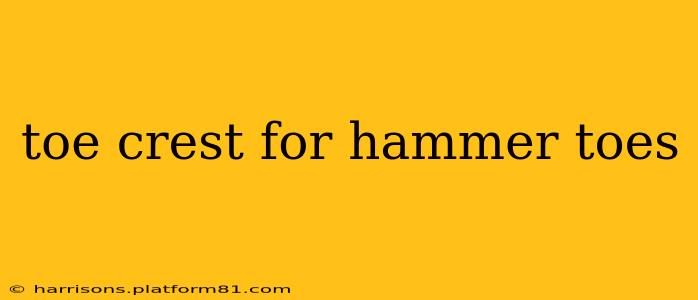Hammer toes, characterized by a bent middle joint that resembles a hammer, can cause pain, discomfort, and difficulty wearing shoes. A toe crest is a common solution explored by individuals seeking relief from hammer toe symptoms. But what exactly is a toe crest, and how effective is it? This comprehensive guide explores toe crests, addressing common questions and providing valuable insights into their use for hammer toe correction and pain management.
What is a Toe Crest?
A toe crest, also known as a toe straightener or hammer toe corrector, is a small, often silicone or gel, device designed to gently straighten the bent toe and alleviate pressure points. They are typically worn inside shoes and work by applying pressure to the affected joint, encouraging it to gradually return to its natural position. Different types exist, varying in material, shape, and the degree of support they provide. Some are simple sleeves that gently hold the toe, while others feature more rigid supports.
How Effective Are Toe Crests for Hammer Toes?
The effectiveness of toe crests varies significantly depending on the severity of the hammer toe deformity and individual factors. For mild cases of hammer toes, toe crests can provide substantial relief by reducing pressure on the affected joint and improving comfort when wearing shoes. They can be particularly helpful in alleviating pain and preventing corns or calluses that often develop with hammer toes. However, for severe or longstanding hammer toe deformities, toe crests alone may not be sufficient.
Do Toe Crests Correct Hammer Toes Permanently?
No, toe crests primarily provide symptomatic relief rather than a permanent cure. While they can help improve the appearance and alignment of the toe, they do not address the underlying cause of the deformity. For permanent correction, more involved medical interventions may be necessary, such as surgery or custom orthotics. Toe crests are best viewed as a conservative, non-invasive approach to pain management and symptom relief.
What Are the Different Types of Toe Crests?
Toe crests are available in several forms:
-
Gel Toe Separators: These soft gel pads gently separate the toes and reduce friction and pressure. They are ideal for mild cases or as a preventative measure.
-
Silicone Toe Straighteners: These devices are usually more structured than gel separators, providing more support and correction. They often feature a loop or strap to hold the toe in place.
-
Toe Straightening Sleeves: These sleeves gently encapsulate the toe, providing compression and support.
-
Rigid Toe Correctors: These are more supportive and feature a harder material, providing stronger correction. However, they can be less comfortable for some individuals.
The best type of toe crest depends on the severity of the hammer toe, individual comfort, and personal preferences.
Are Toe Crests Comfortable to Wear?
The comfort of wearing a toe crest varies depending on the individual and the type of device. Some individuals find them comfortable enough to wear all day, while others may experience some discomfort initially. It's crucial to start with shorter wear periods and gradually increase the duration as tolerated. Choosing the right size and type of toe crest is essential for optimal comfort. If you experience significant discomfort, you should remove the device and consult a podiatrist.
Where Can I Buy a Toe Crest?
Toe crests are widely available online and at various pharmacies, drugstores, and medical supply stores. Online retailers offer a wide selection of brands and styles, often with customer reviews that can help guide your purchase.
When Should I See a Podiatrist About My Hammer Toes?
While toe crests can provide relief, it's crucial to consult a podiatrist if:
- Your hammer toe is severe or worsening.
- You experience significant pain or discomfort.
- Your symptoms are not improving with conservative measures.
- You have other foot problems, such as bunions or arthritis.
A podiatrist can accurately diagnose the problem, recommend appropriate treatment, and rule out any other underlying conditions. They may suggest more invasive treatments like surgery if necessary.
Remember, this information is for educational purposes and should not be considered medical advice. Always consult with a healthcare professional for diagnosis and treatment of any medical condition.
